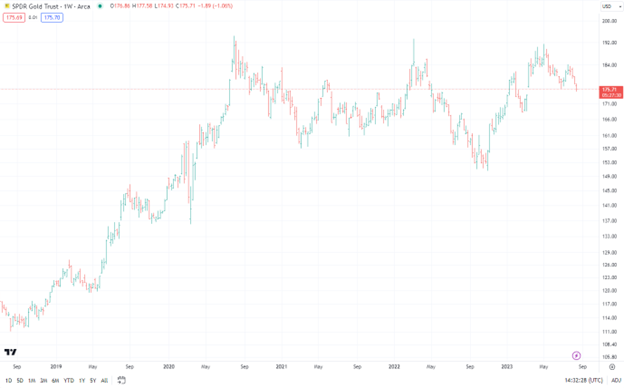
Are new high gold prices coming? Possibly yes.
This to me isn’t about gold being a “store of value” (it isn’t by definition), but rather about path interaction to stock market volatility. Gold has remained a reliable investment, especially during periods of high volatility in the stock market.
Gold can make new highs if I’m right about a credit event.
When looking at the top 20 drawdowns for the S&P 500 going back to 1961, Gold does act as an imperfect hedge, and is a risk-off trade, just like Treasuries on average. pic.twitter.com/ri7CWX96AP
— Michael A. Gayed, CFA (@leadlagreport) August 18, 2023
The fundamentals that predominantly influence gold prices in the short to medium term are real yields and the dollar. For the past two years, real yields have kept a lid on gold. However, it seems that real yields are nearing their peak for this cycle. They are not likely to return to negative territory in the immediate future.
Real Yields, U.S. Dollar Influence Gold
The fact that the gold sector has held up so well, despite the biggest spike in real yields in decades, reaffirms the bullish long-term case for gold independent of flight-to-safety dynamics. The relationship between gold and real yields was almost insignificant during the pre-quantitative-easing era. This partly explains why precious metals have held up relatively well during this period.
It’s noteworthy that gold and the precious metal sector tend to perform relatively well as we reach the latter stages of the business cycle. The conditions for a significant move higher in precious metals are slowly coming together.

The correlation between gold and the U.S. equity market is another relationship to observe. Long-term correlation tends to be roughly 0. However, this correlation can turn negative during periods of heightened stress and volatility. This year, we have seen gold and equities react in similar directions to changes in dollar strength and yields. However, we did see gold outperform during the onset of the U.S. banking crisis in March as its safe-haven appeal came to the fore.
What about fundamentals and broader demand? According to the World Gold Council, 2022 was the strongest year for gold consumption for more than a decade. Demand for gold during the first quarter of 2023 fell by 13% year over year. However, the total supply of gold rose slightly during the first quarter due to a rise in mine production and recycling.
The outlook for gold prices is finely balanced here. An end to the Federal Reserve’s rate-tightening cycle, a weaker U.S. dollar, or an economic downturn would push the price higher due to its impact on investors’ appetite for risk. But if the U.S. and global economies continue to show resilience, interest rates increase, or the U.S. avoids a recession, then gold prices could suffer.
The Bottom Line on Gold Prices
Bottom line? Investing in gold remains a compelling risk-off trade, especially during high-volatility sequences in the stock market.
The long-term bullish case for gold is well-supported by the dynamics of real yields, the dollar, central bank activities, and the correlation between gold and the stock market. Despite facing headwinds from interest rates and demand-supply dynamics, gold’s safe-haven appeal and potential positive reaction to a credit event make it an attractive investment.
On the date of publication, Michael Gayed did not hold (either directly or indirectly) any positions in the securities mentioned in this article. The opinions expressed in this article are those of the writer, subject to the InvestorPlace.com Publishing Guidelines.





